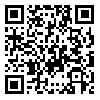Volume 9, Issue 7 (Supplement: Community Health. 2019)
J Research Health 2019, 9(7): 568-574 |
Back to browse issues page
Download citation:
BibTeX | RIS | EndNote | Medlars | ProCite | Reference Manager | RefWorks
Send citation to:



BibTeX | RIS | EndNote | Medlars | ProCite | Reference Manager | RefWorks
Send citation to:
Dehghan Sarvolia N, Dehghani A. Role of Early Maladaptive Schemas and Attachment Styles in the Prediction of Thoughtful Rumination in Individuals with Body Dysmorphic Disorder. J Research Health 2019; 9 (7) :568-574
URL: http://jrh.gmu.ac.ir/article-1-1451-en.html
URL: http://jrh.gmu.ac.ir/article-1-1451-en.html
1- Department of Clinical Psychology, Najafabad Branch, Islamic Azad University, Najafabad, Iran.
2- Department of Clinical Psychology, Najafabad Branch, Islamic Azad University, Najafabad, Iran. ,dehghani2016@phu.iaun.ac.ir
2- Department of Clinical Psychology, Najafabad Branch, Islamic Azad University, Najafabad, Iran. ,
Abstract: (3169 Views)
Background: Body dysmorphic disorder (BDD) has been characterized by mental preoccupation about an imagined or exaggerated physical deficit, which includes any part of the body. The purpose of the current research was to identify the early maladaptive schemas and attachment styles in the prediction of thoughtful rumination in individuals with body dysmorphic disorder.
Methods: The research design is post-event research and descriptive-correlation type. The research sample includes all of women clients at Cosmetic Surgery clinics of Isfahan city in 2016. 70 individuals were selected by purposive sampling, who obtains a score more than the cut point in the Yale-Brown Obsessive-Compulsive Scale. The participants filled the questionnaires of the Young Early Maladaptive Schema Questionnaire, Collins & Read's Adult Attachment Scale, and the Rumination Response Scale (RRS). The data were analyzed by the SPSS-23 software version.
Results: The results of the Pearson correlation coefficient showed a positive and significant relation between maladaptive schemas and thought rumination in the clients and the anxious/ambivalent attachment style had a significant relationship with thoughtful rumination (R= 0.44). Stepwise regression analysis showed that in the early maladaptive schemas variable, the vigilance and maladaptive schema of flaw/shame, and in attachment styles, the anxious/ambivalent attachment style are better predictors of thoughtful rumination in clients.
Conclusion: The conclusions reveal that in the treatment of Body Dysmorphic Disorders, it’s important to pay attention to think contents and attachment styles in clients, and using schema therapy technics to help patients to free from unnecessary and ruminative thoughts.
Methods: The research design is post-event research and descriptive-correlation type. The research sample includes all of women clients at Cosmetic Surgery clinics of Isfahan city in 2016. 70 individuals were selected by purposive sampling, who obtains a score more than the cut point in the Yale-Brown Obsessive-Compulsive Scale. The participants filled the questionnaires of the Young Early Maladaptive Schema Questionnaire, Collins & Read's Adult Attachment Scale, and the Rumination Response Scale (RRS). The data were analyzed by the SPSS-23 software version.
Results: The results of the Pearson correlation coefficient showed a positive and significant relation between maladaptive schemas and thought rumination in the clients and the anxious/ambivalent attachment style had a significant relationship with thoughtful rumination (R= 0.44). Stepwise regression analysis showed that in the early maladaptive schemas variable, the vigilance and maladaptive schema of flaw/shame, and in attachment styles, the anxious/ambivalent attachment style are better predictors of thoughtful rumination in clients.
Conclusion: The conclusions reveal that in the treatment of Body Dysmorphic Disorders, it’s important to pay attention to think contents and attachment styles in clients, and using schema therapy technics to help patients to free from unnecessary and ruminative thoughts.
Type of Study: Orginal Article |
Subject:
● International Health
Received: 2017/08/15 | Accepted: 2019/05/26 | Published: 2020/07/18
Received: 2017/08/15 | Accepted: 2019/05/26 | Published: 2020/07/18
| Rights and permissions | |
 |
This work is licensed under a Creative Commons Attribution-NonCommercial 4.0 International License. |









